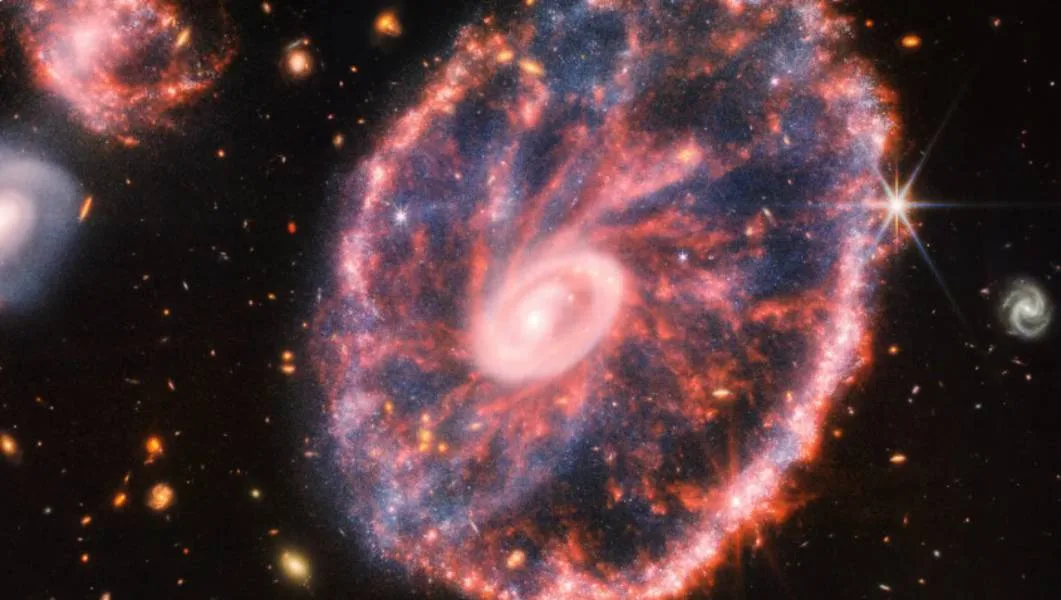On Aug. 2, 2022, the James Webb Space Telescope peered deep into the history and future of the scenic Cartwheel Galaxy.
The James Webb Space Telescope, which orbited the earth a few weeks ago, unfurled itself, organized its optics, and delivered us our very first batch of stunning pictures and data.
Now that it’s getting down to business, you’ll be shocked when you see some photos that are out of this world. We’re looking at the Cartwheel Galaxy, a place NASA described as “chaos” and “remarkable.”
“The bright core of the galaxy, which is home to huge star clusters, is also hot dust,” NASA said in a statement on Tuesday.
“On the other hand, the outer ring, which has expanded for about 440 million years, is dominated by star formation and supernovas.”
According to NASA, Webb’s observations underscore that the Cartwheel is in a very transient phase.
The galaxy, which was presumably a normal spiral galaxy like the Milky Way before its collision, will continue to remodel as a result.
The Hubble Space Telescope also admired its magnificence. NASA’s Chandra X-ray Observatory view is a gorgeous picture.
NASA, ESA, and the Canadian Space Agency are collaborating on Webb to investigate the early universe, examine exoplanets, and offer new insight into our own solar system.
The shimmering Cartwheel Galaxy indicates that Webb has only just begun. Many more “wow” moments are in store.
The Cartwheel data divulges information about the age of the stars in the galaxy and about the dust that makes up the “spokes” in the wheel. Webb observed silicate dust there, a kind that is prevalent on Earth.
The Cartwheel galaxy, a dramatic galaxy, has been examined by other telescopes, including the Hubble Space Telescope.
Webb has now uncovered new insights into the nature of the Cartwheel, a galaxy shrouded in mystery given the amount of dust that obscures the view. Infrared light, which Webb detects, uncovers new insights into the nature of the Cartwheel.
The bright core comprises a lot of hot dust, with huge young star clusters being its brightest areas. On the other hand, the outer ring, which has expanded for about 440 million years, is dominated by star formation and supernovas. As this ring expands, it plows into surrounding gas and triggers star formation.
The Cartwheel Galaxy, which can be found in the Sculptor constellation 500 million light-years away, is a sight you don’t see every day and it’s appearance, like that of a wagon wheel, is the result of a violent event—a high-speed collision between a large spiral galaxy and a smaller galaxy that is not depicted in this picture.
Galactic collisions result in a cascade of smaller events between the galaxies involved, and the Cartwheel is no exception.
The Cartwheel Galaxy, which was hit by an enormous intergalactic object, has suffered serious damage to its structure and morphology.
Because the collision caused the ripples to spread outward from the centre in the same way as a stone in a pond, astronomers refer to the ring galaxies as ‘ring galaxies.’ Spiral galaxies such as our Milky Way are much more common than ring galaxies, which are less common.
The Near-Infrared Camera (NIRCam), an instrument on the James Webb Space Telescope that observes near-infrared light between 0.6 and 5 microns, captures a range of infrared light that reveals even more stars than visible light does.
Infrared light, which is less obscured by dust in young stars, exposes a range of wavelengths from 0.6 to 5 microns.
In this image, NIRCam data are coloured blue, orange, and yellow.
The galaxy has thousands of blue dots that are individual stars or pockets of star formation.
NIRCam also reveals the variation in the older star populations compared to the younger star populations outside of it, which are clumpy in shape and associated with a lot of dust.

The enormous young star clusters live in the brightest areas of the bright core, which is dominated by hot dust and star formation.
On the other hand, the outer ring, which has expanded for about 440 million years, is dominated by star formation and supernovas. As this ring expands, it plows into surrounding gas and triggers star formation.
Prior to Webb scanning the cosmos, astronomers declared in April 2022 that they may have found the farthest galaxy yet, HD1.
HD1 is considered to be one of the earliest and most distant galaxies discovered in the observable universe. It is observed as it was about 330 million years after the Big Bang, which occurred 13.8 billion years ago.
It has a light-travel distance of 13.5 billion light-years from Earth, and a present proper distance of 33.4 billion light-years because of the universe’s expansion.







